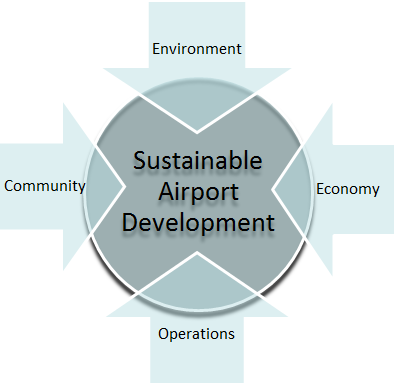Airport Sustainability
Sustainable actions —
- Reduce environmental impacts.
- Help maintain high, stable levels of economic growth.
- Help achieve "social progress", a broad set of actions that ensure organizational goals are achieved in a way that's consistent with the needs and values of the local community.
FAA programs such as the Noise Compatibility Program and Voluntary Airport Low Emissions (VALE) Program help airports achieve these goals. Airport sustainability plans take these efforts a step further by fully integrating sustainability into airport planning.

Airport Sustainability Planning
We are providing eligible airports across the United States with Airport Improvement Program grant funds to develop comprehensive sustainability planning documents. These documents include initiatives for reducing environmental impacts, achieving economic benefits, and increasing integration with local communities. To date, we have provided grants to 44 airports.
Sustainability Master Plans and Airport Sustainability Plans
Sustainability Master Plans fully integrate sustainability into an airport's long-range planning. A Sustainable Management Plan is a stand-alone document. Both documents achieve similar objectives. They use baseline assessments of environmental resources and community outreach to identify sustainability objectives that will reduce environmental impacts, realize economic benefits, and improve community relations.
Participating Airports
| Airport (and links to plans) | State |
|---|---|
| Akron-Canton Regional Airport | Ohio |
| Arnold Palmer Regional Airport, Latrobe | Pennsylvania |
| Bert Mooney Airport, Butte | Montana |
| Cheyenne Regional Airport - Jerry Olson Field | Wyoming |
| Coeur D´Alene-Pappy Boyington Field | Idaho |
| Dallas-Fort Worth International Airport | Texas |
| Dayton-Wright Brothers Airport | Ohio |
| Denver International Airport | Colorado |
| Flagstaff Pulliam Airport | Arizona |
| Fort Lauderdale-Hollywood International | Florida |
| Fresno Yosemite International Airport (PDF, 9.7 MB) | California |
| General Aviation Airports, State of Colorado | Colorado |
| General Aviation Airports, Commonwealth of Virginia | Virginia |
| George Bush Intercontinental Airport, Houston | Texas |
| Gulfport-Biloxi International Airport (PDF, 2.1 MB) | Mississippi |
| Hartsfield-Jackson Atlanta International Airport (PDF) | Georgia |
| Honolulu International Airport | Hawaii |
| Huntington Tri-State Airport (PDF, 8.7 MB) | West Virginia |
| Huntsville International Airport - Carl T. Jones Field | Alabama |
| Ithaca-Tompkins Regional Airport (PDF) | New York |
| James M. Cox Dayton International Airport (PDF, 14.3 MB) | Ohio |
| Juneau International Airport | Alaska |
| Kent State University | Ohio |
| Logan International Airport | Massachusetts |
| Minneapolis-St. Paul International Airport | Minnesota |
| Monterey Airport | California |
| Nashville International Airport (PDF) | Tennessee |
| Newark Liberty International Airport | New Jersey |
| Newport News/Williamsburg International Airport | Virginia |
| Newton City-County Airport (PDF) | Kansas |
| Northeast Florida Regional Airport (PDF, 61.8 MB) | Florida |
| Northwest Arkansas Regional Airport | Arkansas |
| Portland International Jetport | Maine |
| Outagamie County Regional Airport (PDF) | Wisconsin |
| Roberts Field - Redmond Municipal Airport | Oregon |
| Salt Lake City International Airport | Utah |
| Seattle-Tacoma International Airport | Washington |
| State College Regional Airport | Pennsylvania |
| Tampa International Airport | Florida |
| Teterboro Airport | New Jersey |
| Vero Beach Municipal Airport | Florida |
| William P. Hobby Airport, Houston | Texas |
| Yeager Airport, Charleston | West Virginia |
Program Guidance and Lessons Learned
In May 2010, we published interim guidance for the Sustainability Master Plan Pilot Program (see "Resources" below). We made the interim guidance purposefully broad to enable airports to develop diverse and innovative approaches to sustainability planning.
The FAA has published a report of Lessons Learned from FAA-funded sustainability plans. This report is in the "Resources" section below.
Resources
- ACRP Synthesis 66, "Lessons Learned from Airport Sustainability Plans" (added June 07, 2016)
- Airport Cooperative Research Program (ACRP) Synthesis 10: Airport Sustainability Practices
- FAA Lessons Learned from the Sustainable Master Plan Pilot Program (PDF, 629 KB)
- Interim Guidance for FAA's Sustainable Master Plan Pilot Program (PDF)
- Sustainable Aviation Guidance Alliance's (SAGA's) Sustainability Database
